|
|
20-Mule-Team History
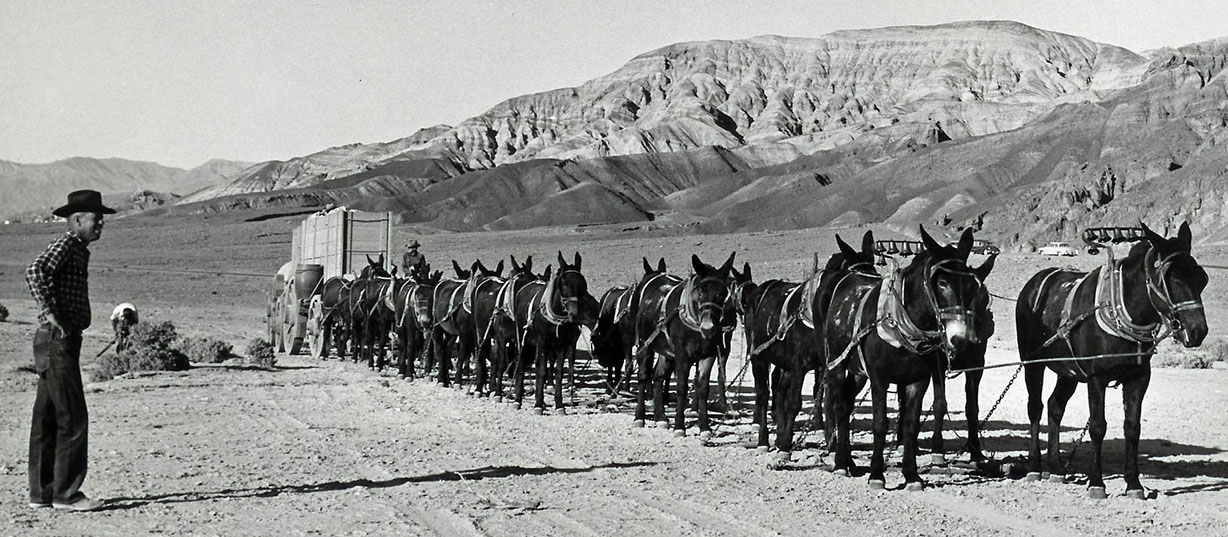 Bruce Morgan looking on his '49ers 20-Mule-Team - in Death Valley
Bruce Morgan looking on his '49ers 20-Mule-Team - in Death Valley
Vasie Cline, just in front of the wagon, is driving the team
(Photo courtesy of Dave & Gale Woodruff - Tales Along El Camino Sierra) |

 03/25 03/25
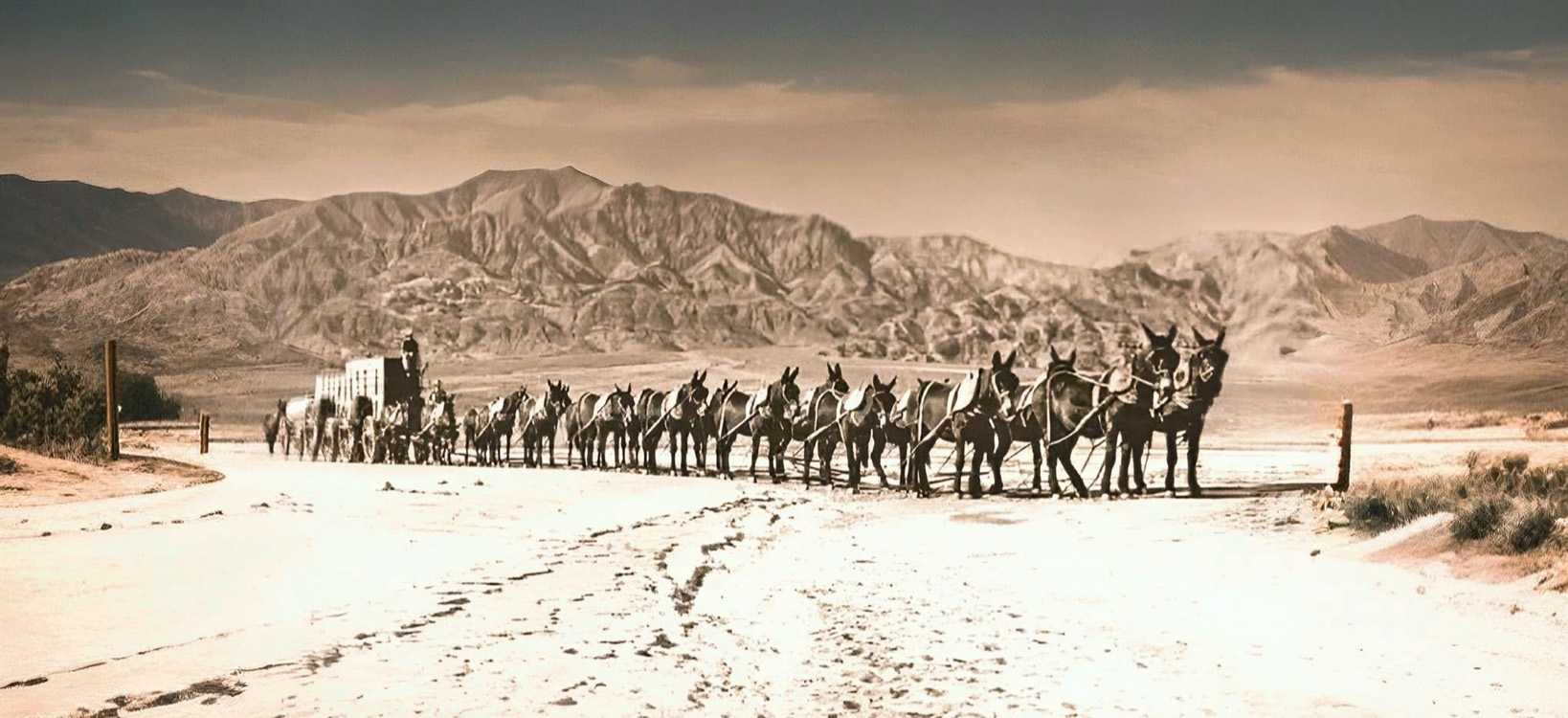 20-Mule-Team - in Death Valley
20-Mule-Team - in Death Valley
Between 1883 and 1889, a 20-mule team made the arduous 165-mile journey to the railhead in Mojave, California, hauling 10 short tons of borax ore per trip. The wagons' rear wheels, towering at seven feet, were reinforced with 1-inch-thick iron tires. The solid oak wagon beds measured 16 feet in length and 6 feet in depth, with an empty weight of 7,800 pounds. The entire convoy stretched over 180 feet, comprising three wagons: the first acted as a trailer, the second was the "tender" or "back action," and the last served as a water tank.
When fully loaded, the mule train weighed around 73,200 pounds. The water tank, which held 1,200 US gallons, provided the mules with water throughout the journey, and sometimes an additional 500-gallon water wagon was added for dry camps along the route. Over six years, the teams successfully transported more than 20 million pounds of borax out of Death Valley.
The horses closest to the wagon, known as wheelers, were ridden by one of the two teamsters required to operate the wagons. Though larger than the mules, the horses were less intelligent and less adapted to the harsh desert conditions. Mules, on the other hand, were favored for desert freighting, as described in Remi Nadeau's Nadeau's Freighting Teams in the Mojave.
The teamster controlled the mules using a single long rein, known as a "jerk line," and a blacksnake whip. He usually rode the left wheeler but could also manage the team from the trailer seat, especially when navigating steep descents. The swamper, who typically rode on the trailer, operated the brake on hilly terrain. Armed with a can of small rocks, the swamper could nudge any sluggish mules back to work. Both men were responsible for preparing the team, taking care of the mules' needs, and addressing any repairs or veterinary issues. During midday breaks, the mules were fed and watered while still harnessed, while night stops included corrals and feed boxes. Each day's journey averaged about 17 miles, with the entire one-way trip taking around ten days. Cabins were built at night stops for the teamsters and swampers to rest.
|


 11/24 11/24
|
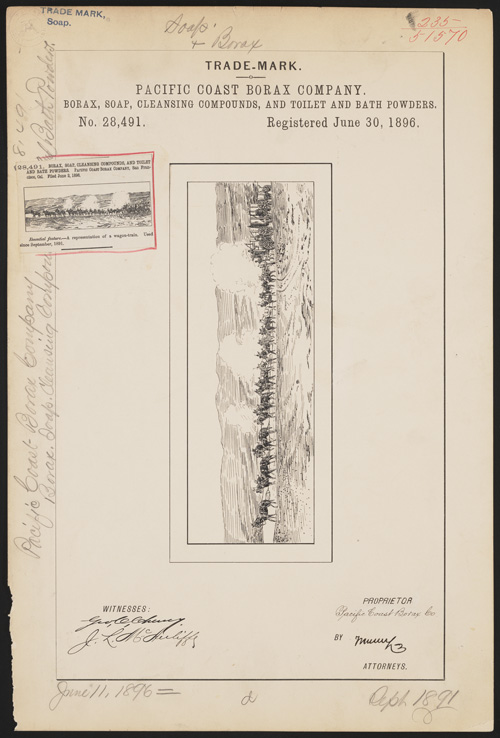 Pacific Coast Borax Company Trademark Registration - June 30, 1896
Pacific Coast Borax Company Trademark Registration - June 30, 1896
(Photo courtesy of the Library of Congress)
|

What Became of the 20-Mule Freighters?
by Mary Joe Burton
(Story courtesy Mike Vrendenburg)

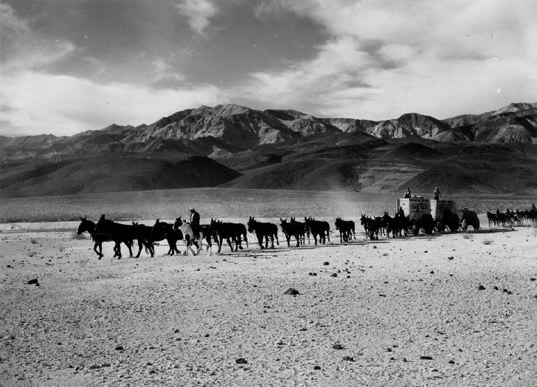
20 Mule
Team in Panamint Valley
(Frasers Foto Card) |
The
20 mule team (pictured left) driven by Russ Spainhower left Lone
Pine with Bruce Morgan's [see Mt. Whitney Pack Trains history]
Group of '49ers, November 23, 1949 in a treck across Panamint
Valley to Death Valley for the December 2nd Centennial.
These big wagons with wheels that weigh over eight hundred pounds
each, pulled by ten pair of mules driven with only a single "jerk
line", traveled at a speed averaging two miles an hour and
required ten days to make the trip from Lone Pine to Furnace
Creek Ranch in Death Valley. |
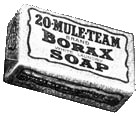
|
For
more information about Bruce Morgan see Mt. Whitney Pack Trains history |

 08/22 08/22
|
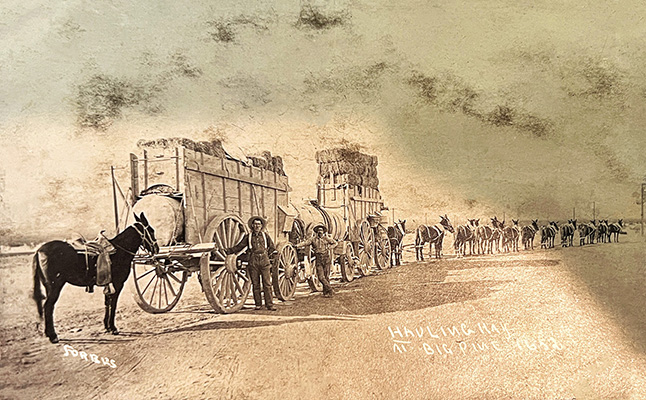 20-Mule Team hauling alfalfa hay in Big Pine
20-Mule Team hauling alfalfa hay in Big Pine
(Photo courtesy of Pam Milligan Vaughan - Photo from her aunt Dorothy Moxley's Photo Album) |


Calisphere - University of California Burton Frasher Photo - 1936 |
|
|


20 Mule Team
rigging photos courtesy of Paul Lamos from the archives of his
stepfather, and former MWPT packer, - Bill Smart. |
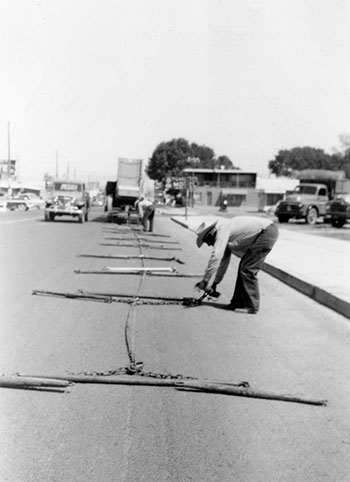 Bruce Morgan
laying out the 20 mule team rigging on U.S. 395 in Lone Pine.
Bruce Morgan
laying out the 20 mule team rigging on U.S. 395 in Lone Pine. |
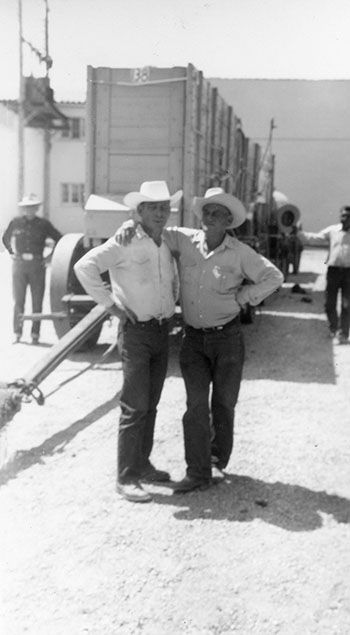 L to R: Vasie
Cline, Billy Bishop, Leppy Diaz, Leakey Olivas
L to R: Vasie
Cline, Billy Bishop, Leppy Diaz, Leakey Olivas
(see enlarged photo for view of all) |
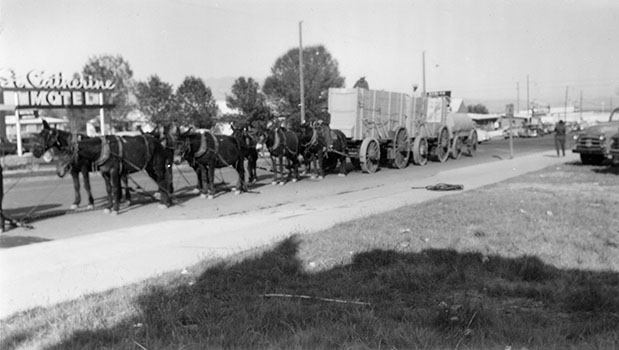 Hitched up and
ready to leave Lone Pine for Furnace Creek.
Hitched up and
ready to leave Lone Pine for Furnace Creek. |
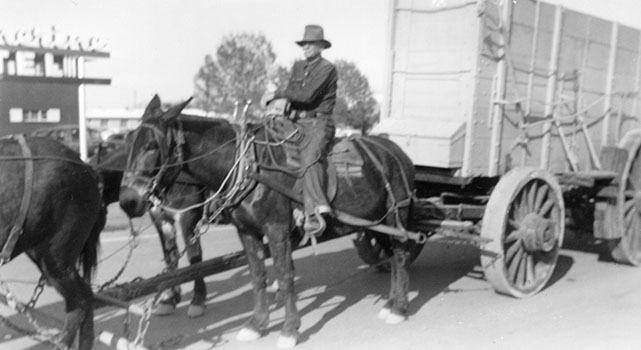 Vasie Cline
riding 'Ike' the mule. Vasie was always the driver of the
Vasie Cline
riding 'Ike' the mule. Vasie was always the driver of the
20 mule team. |
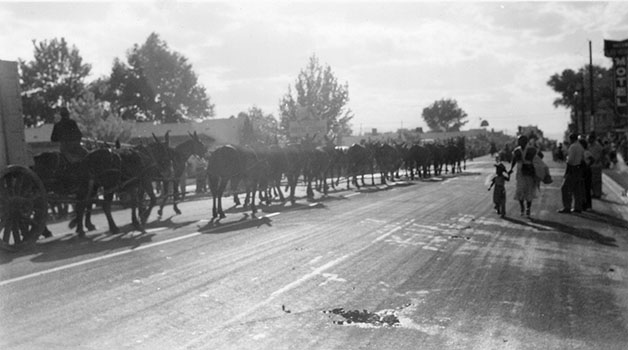 20 Mule
Team in Lone Pine
20 Mule
Team in Lone Pine |
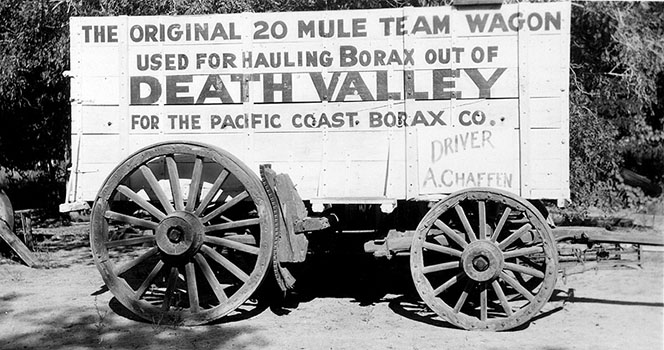 20 Mule
Team Wagon
20 Mule
Team Wagon |
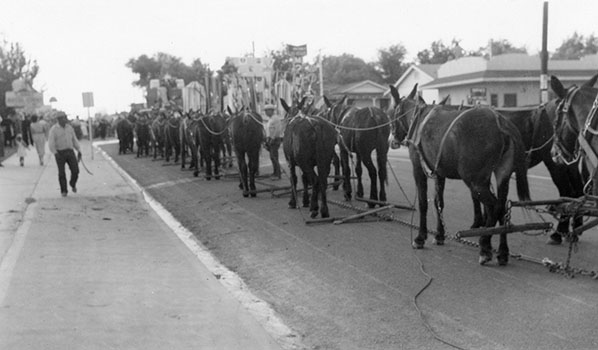 Checking out
the 20 mule team rigging before leaving Lone Pine
Checking out
the 20 mule team rigging before leaving Lone Pine |
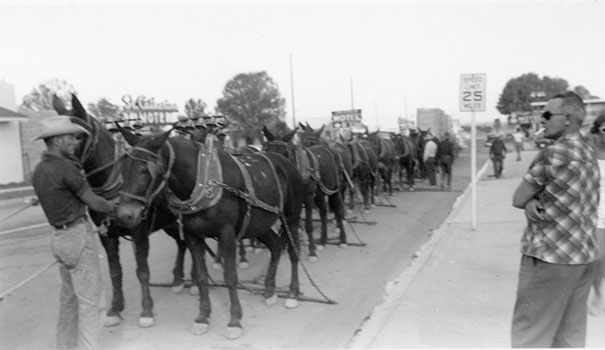 Checking out
the rigging on the lead mules.
Checking out
the rigging on the lead mules. |
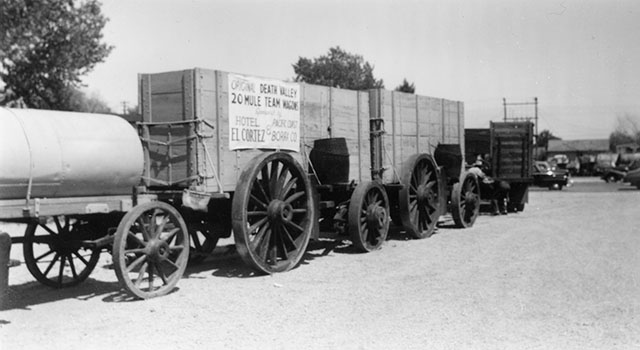 20 Mule
Team Wagons
20 Mule
Team Wagons |
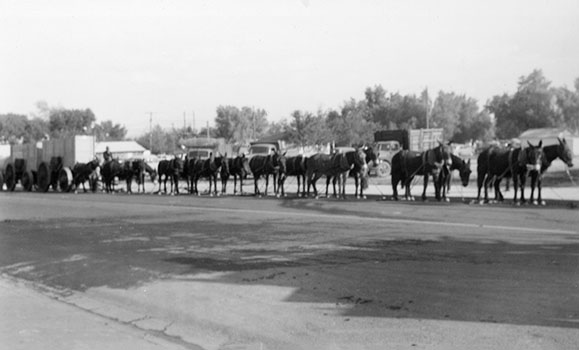 20-mule
team all hitched up and ready to go.
20-mule
team all hitched up and ready to go. |
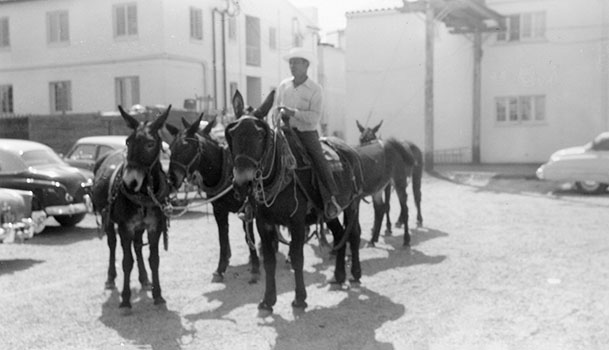 Billy Bishop
(who packed for Mt. Whitney Pack Trains for many years during
the 1950s) waiting to place the mules in their position in the
20 mule team.
Billy Bishop
(who packed for Mt. Whitney Pack Trains for many years during
the 1950s) waiting to place the mules in their position in the
20 mule team. |
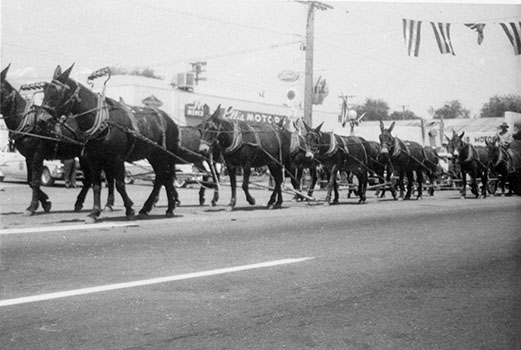 20 Mule
Team in Lone Pine
20 Mule
Team in Lone Pine |
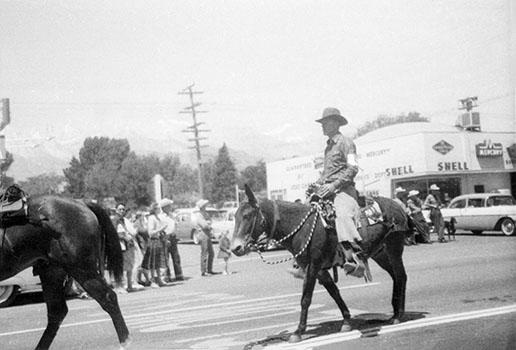 Bill Smart
riding 'Sam-ule'
Bill Smart
riding 'Sam-ule' |
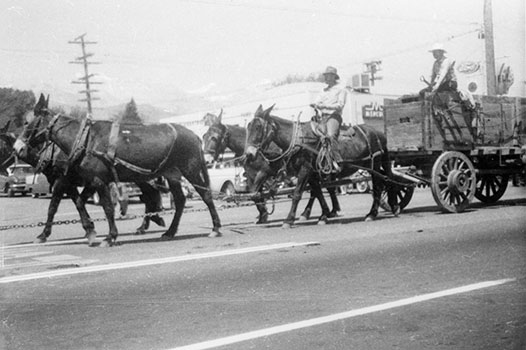 20 Mule
Team in Lone Pine
20 Mule
Team in Lone Pine |
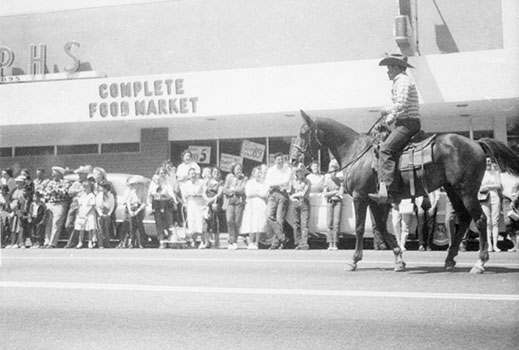 Tommy Jefferson
taking the lead out.
Tommy Jefferson
taking the lead out. |
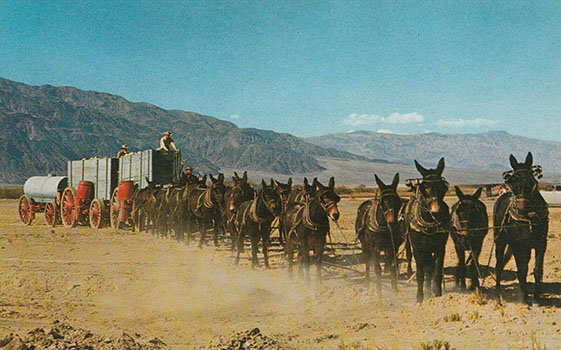 20 Mule Teami in action in Death Valley
20 Mule Teami in action in Death Valley
(Ebay posting) |

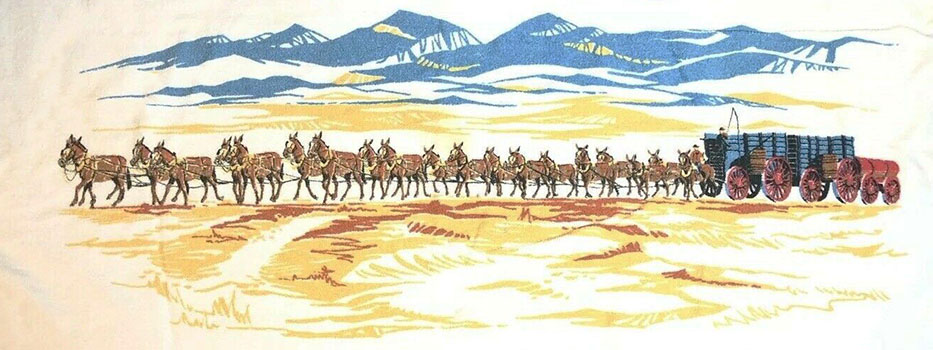
20 Mule Team artwork on cloth
(Ebay posting)
|

49'er
20 Mule Team Dinner Held at the Sahara Hotel
in
Las Vegas, Nevada on 15 May 1953
(photo courtesy
of Ben Baker)
|
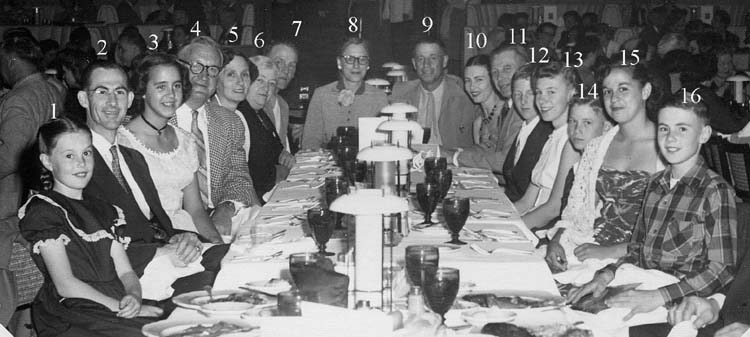
|
L to R
around the table. |
1. Ann
Higgins
2. Dr. Joseph P. Higgins
3. Roberta Morgan Peters
4. David B. Hill
5. Grace Morgan
6. Kathrine Spainhower
7. Dr. William C. Smart
8. Glayds Thompson
9. Bruce Morgan
10. Norma Higgins
11. Ernie Thompson
12. Mike Baker
13. Jean Crilly Coburn
14. Richard Morgan
15. Enid Morgan Hansen
16. Joe Pat Higgins |
|

The Mule
by Theodore H. Savory
 The 20-Mule-Team & Borax Bill
The 20-Mule-Team & Borax Bill
by The Pacific Coast Borax Co.


20
Mule Team Days

 10/22 10/22
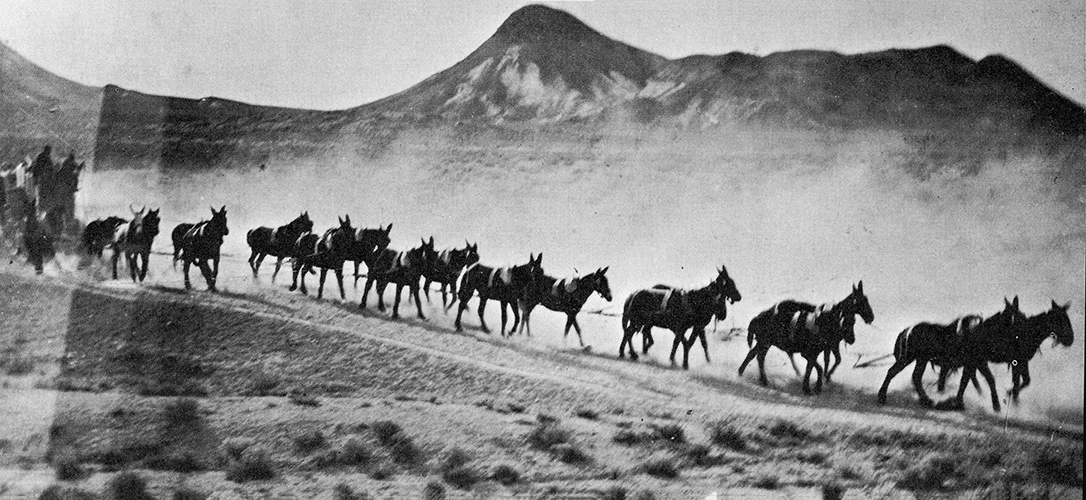 William Arcularius and his twenty-mule hitch hauling borax in Death Valley - circa 1882
William Arcularius and his twenty-mule hitch hauling borax in Death Valley - circa 1882
From The Westerners Los Angeles
Corral Brand Book 12
(Photo courtesy Rich McCutchan archives) |

 10/22 10/22
"The Jerk Line Team - Freighting in California and the West"
by Irving Wills, M.D.


Wagons
to Haul Through Hell
by Harold O. Weight



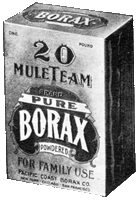 |
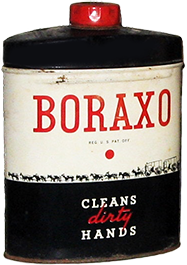
|
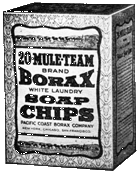 |
|
Commanding
the 20 Mule Team
Fourteen, 16, 18 mules, plus 2 horses, supplied the draypower.
The front span of mules were the "leaders"; the 2 horses
next to the wagon, and hitched to the tongue, were the "wheelers."
Twenty was the usual total, and 20 were needed on the steep incline
of Windy Gap, heaving some thirty tons of dead weight, including
the borax, the water cart, the unwieldy wagons themselves, and
a vast assortment of tools, food supplies and cooking equipment
attached to the sides. Altogether the outfit, in action, looked
like a cross between a circus wagon and a Connecticut peddler's
cart. Not since the construction of the Pyramids of Egypt had
such an impressive rig crossed a desert.
Stretched
out on the road, the leaders were a long 120 feet from the skinner,
who rode the nigh wheeler or sat enthroned high on the front
of the fore wagon. For such an entourage reins were useless.
Instead, the skinner held a stout, cotton jerk line in one hand
and a whip with a 6-foot stock and 22-foot lash in the other.
The
single line was strung through rings in the harnesses of the
twenty nigh mules to the bit of the nigh leader. To make a left
turn, the skinner pulled steadily on the line. To make a right
turn, the line was given a series of short jerks; the jerks made
the leader instinctively throw up his head, which in turn pulled
a strap attached to the right side of the bit-a system as simple
as it was ingenious. The leader took its cues from the line;
the rest followed.
 Commanding
a twenty-mule borax wagon was something like sailing a full-rigged
schooner singlehanded, using an oar for a rudder. In managing
the team the line was a help; the whip that could flick a fly
from the ear of the fourth off mule without disturbing a hair
was a help; the brakes were useful; the swamper riding the trail
wagon and working its brake was occasionally credited with giving
some assistance; and the box full of rocks kept on the seat to
pelt perverse mules beyond the reach of the whip was indispensable.
But all these aids were of minimum value in controlling the team,
compared to the effectiveness of the skinner's tongue.
An
inspired tongue and flexible vocal organs were what kept the
animals on course and pulling together. The teamster's words
had all the sting of his whip. That badge of trade was held in
reserve as a threat and rarely applied, but from the moment a
skinner mounted his seat with a "Git ep, ye God-damned -
git ep," the flow of profane eloquence was unreserved. The
vocabulary, to be sure, was limited. Mule skinners kept it that
way on purpose, so they maintained, in order not to strain the
intelligence of the animals or the lean-witted assistant, the
swamper.
The
profusion of four-, five-, and six-letter words had aim, thrust
and cut of unmistakable meaning and nuance. Mules were sensitive
beasts, each with a name, and when that name was linked with
the bite of the driver's rebuke, ears perked up, a tail wilted,
a quiver of terror or embarrassment seemed to pass over the hide,
as though a lash had struck.
The
yarn about the skinner who was converted overnight by a transient
evangelist originated at Mojave. In fact, the gospel bearer was
so proud of his proselyte that he accompanied him to the wagon
next morning to see him off. With the preacher looking on from
below, the skinner swung up to his high seat, sober, constrained,
humbled.
There
he sat for a long moment, trying to summon the magic words that
normally set his team in motion. For the first time in his life
he was tongue tied, totally bereft of his powers of persuasion.
The evangelist had deprived him of the Biblical vocabulary and
all the mortifying vulgarisms his mules understood. When he finally
bellowed the command to "Get ep," without a single
allusion to the Almighty or the organs of sex, the mules stood
transfixed in their tracks, and reportedly all twenty turned
their heads in unison to stare in wonderment at the master. The
evangelist lost a good convert long before the wagons approached
Windy Gap.
No
question about it, the borax teamster felt compelled to lean
rather heavily on diabolic conjuring. He had to be an unyielding
tyrant, a wizard and an artist, in one. Yet despite the Satanic
invocation, accidents did occur on the road to Mojave. Miscalculation
of a hairbreadth in rounding one of the turns in Windy Gap, the
failure of a leader to respond to a yank of the jerk line at
a moment of urgency, or the tripping of a pointer in leaping
the haul chain, could bring disaster. Everything depended on
everything else, and a minor slip-up could send the whole outfit
into a cliff or over the edge of one.
Commanding
a twenty-mule borax wagon was something like sailing a full-rigged
schooner singlehanded, using an oar for a rudder. In managing
the team the line was a help; the whip that could flick a fly
from the ear of the fourth off mule without disturbing a hair
was a help; the brakes were useful; the swamper riding the trail
wagon and working its brake was occasionally credited with giving
some assistance; and the box full of rocks kept on the seat to
pelt perverse mules beyond the reach of the whip was indispensable.
But all these aids were of minimum value in controlling the team,
compared to the effectiveness of the skinner's tongue.
An
inspired tongue and flexible vocal organs were what kept the
animals on course and pulling together. The teamster's words
had all the sting of his whip. That badge of trade was held in
reserve as a threat and rarely applied, but from the moment a
skinner mounted his seat with a "Git ep, ye God-damned -
git ep," the flow of profane eloquence was unreserved. The
vocabulary, to be sure, was limited. Mule skinners kept it that
way on purpose, so they maintained, in order not to strain the
intelligence of the animals or the lean-witted assistant, the
swamper.
The
profusion of four-, five-, and six-letter words had aim, thrust
and cut of unmistakable meaning and nuance. Mules were sensitive
beasts, each with a name, and when that name was linked with
the bite of the driver's rebuke, ears perked up, a tail wilted,
a quiver of terror or embarrassment seemed to pass over the hide,
as though a lash had struck.
The
yarn about the skinner who was converted overnight by a transient
evangelist originated at Mojave. In fact, the gospel bearer was
so proud of his proselyte that he accompanied him to the wagon
next morning to see him off. With the preacher looking on from
below, the skinner swung up to his high seat, sober, constrained,
humbled.
There
he sat for a long moment, trying to summon the magic words that
normally set his team in motion. For the first time in his life
he was tongue tied, totally bereft of his powers of persuasion.
The evangelist had deprived him of the Biblical vocabulary and
all the mortifying vulgarisms his mules understood. When he finally
bellowed the command to "Get ep," without a single
allusion to the Almighty or the organs of sex, the mules stood
transfixed in their tracks, and reportedly all twenty turned
their heads in unison to stare in wonderment at the master. The
evangelist lost a good convert long before the wagons approached
Windy Gap.
No
question about it, the borax teamster felt compelled to lean
rather heavily on diabolic conjuring. He had to be an unyielding
tyrant, a wizard and an artist, in one. Yet despite the Satanic
invocation, accidents did occur on the road to Mojave. Miscalculation
of a hairbreadth in rounding one of the turns in Windy Gap, the
failure of a leader to respond to a yank of the jerk line at
a moment of urgency, or the tripping of a pointer in leaping
the haul chain, could bring disaster. Everything depended on
everything else, and a minor slip-up could send the whole outfit
into a cliff or over the edge of one.
Excerpt from The Great California Deserts by W. Storrs
Lee
|
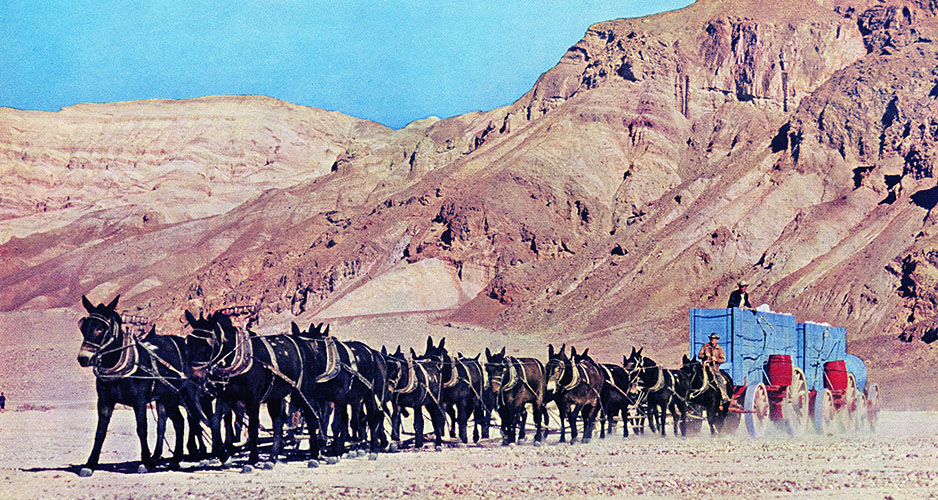 Recently the Pacific Coast Borax Company hitched up a new team, here they are seen against the Black Mountains
Recently the Pacific Coast Borax Company hitched up a new team, here they are seen against the Black Mountains
for the television show Death Valley Days.
(June, 1954 National Geographic Magazine photo) |


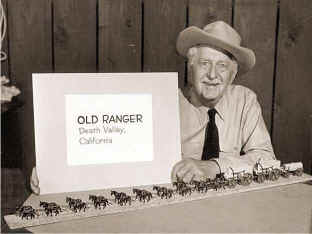
20 Mule Team
Model and the "Old Ranger"
(photo courtesy "The Old Ranger")
|
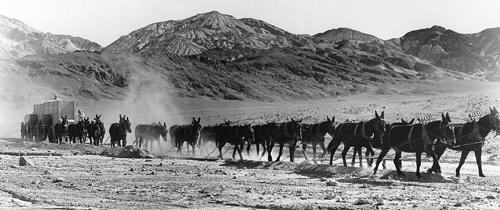 20 Mule Team
Centennial
20 Mule Team
Centennial |
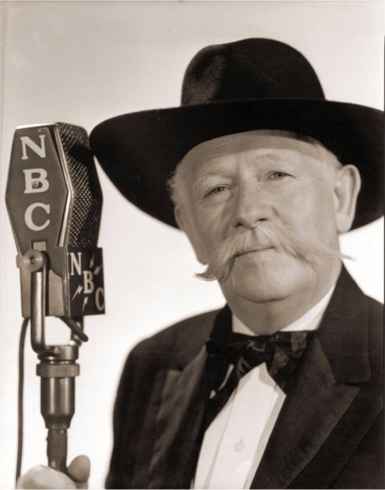 Jack MacBryde
Jack MacBryde |
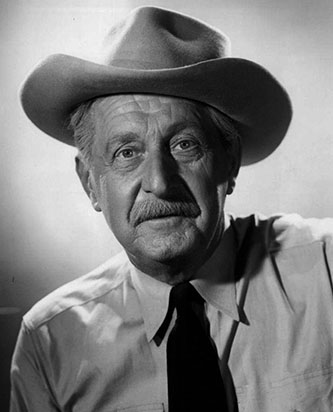 Stanley Andrews"
Stanley Andrews" |
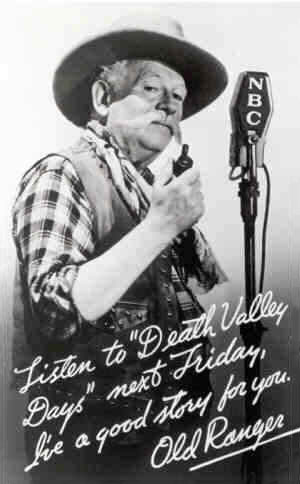 Death Valley
Days - "Old Ranger"
Death Valley
Days - "Old Ranger" |
Two of my favorite "Death Valley Days" TV hosts who played "The Old Ranger." |
|

"Death Valley Days"

 20 Mule Team
20 Mule Team
(Photo courtesy of Bob Pilatos)
|

Floyd R. Evans 1949 photographs of the Death Valley '49ers Centennial
(Photographs courtesy of Rich McCutchan) |
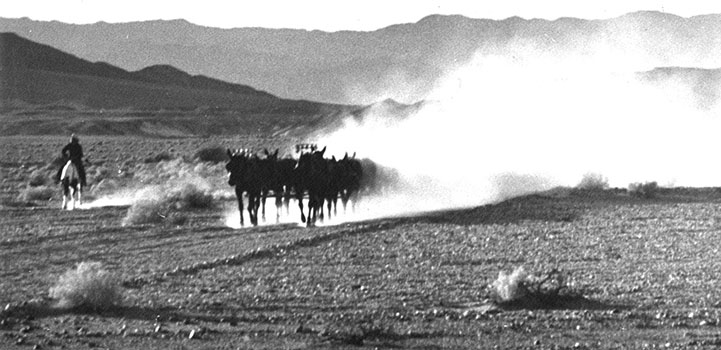
Bruce Morgan - 20 Mule
Team Centennial
|
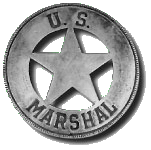 |
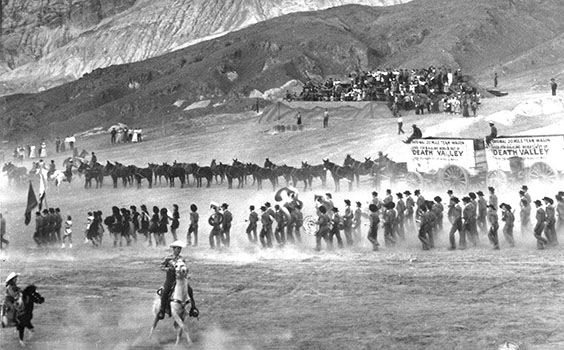
Bruce Morgan - 20 Mule
Team Centennial
|
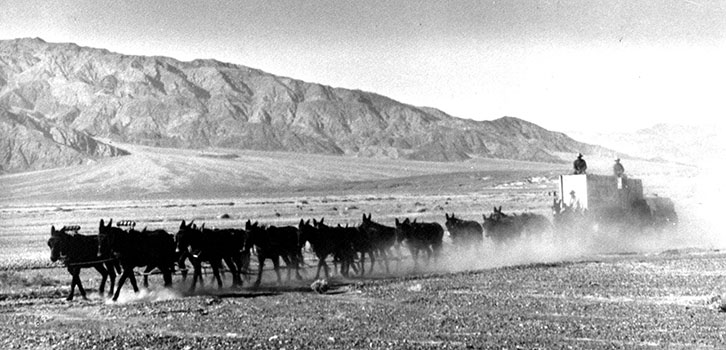 Bruce Morgan - 20 Mule
Team Centennial
Bruce Morgan - 20 Mule
Team Centennial |

Photos courtesy of the Inyo County Sesquicentennial |
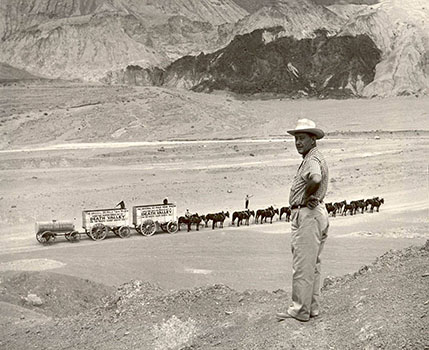 Furnace Creek Inn manager Carlie Scholl admiring Bruce Morgan's 20 Mule Team that came to Death Valley to help celebrate the first '49er Encampment in 1949.
Furnace Creek Inn manager Carlie Scholl admiring Bruce Morgan's 20 Mule Team that came to Death Valley to help celebrate the first '49er Encampment in 1949. |
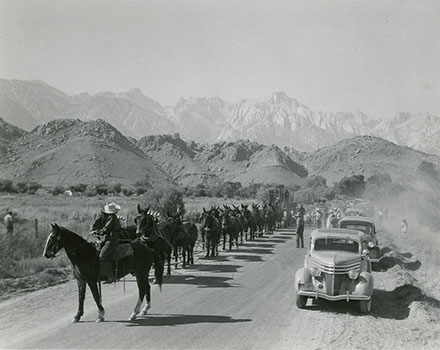 The 20 Mule Team in Lone Pine to help celebrate the Wedding of the Waters in 1937.
The 20 Mule Team in Lone Pine to help celebrate the Wedding of the Waters in 1937. |
20 Mule Team Fotocard Courtesy of Bob Pilatos |
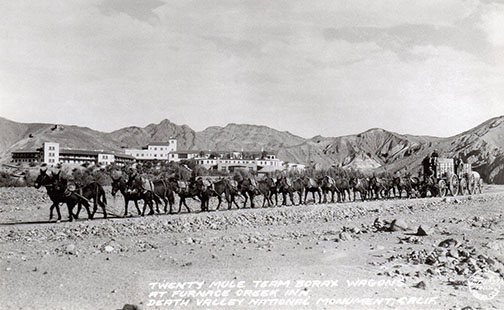 20 Mule Team at Furnace Creek Inn - 1949
20 Mule Team at Furnace Creek Inn - 1949 |

Calisphere - University of California Burton Frasher Photo - 1949 |
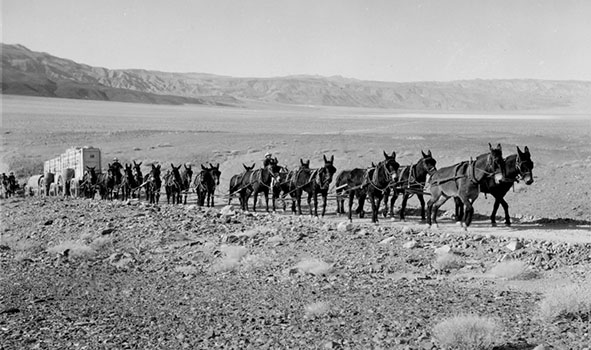 Bruce Morgan's '49er 20 Mule Team crossing Panamint Valley
Bruce Morgan's '49er 20 Mule Team crossing Panamint Valley
|
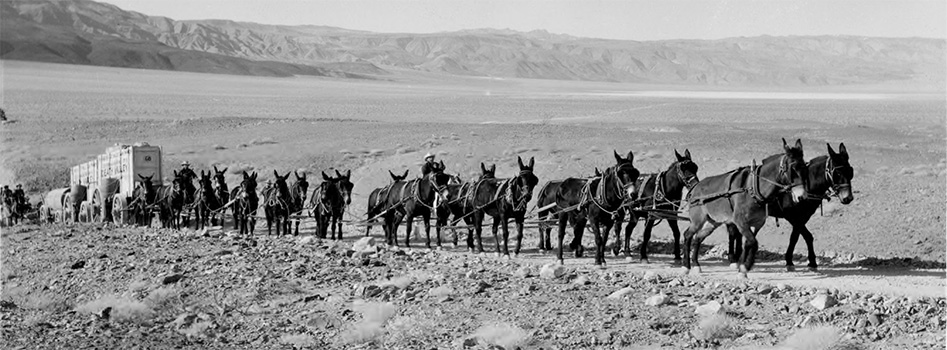 Bruce Morgan's '49er 20 Mule Team crossing Panamint Valley
Bruce Morgan's '49er 20 Mule Team crossing Panamint Valley |
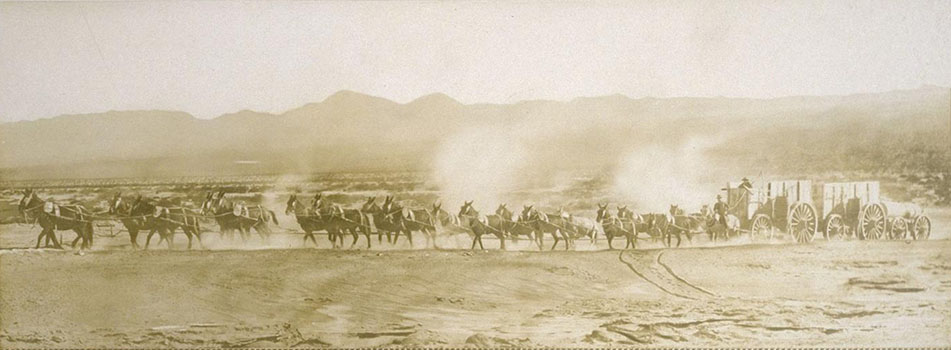 20 Mule Team crossing the Mojave Desert in 1898
20 Mule Team crossing the Mojave Desert in 1898 |

20
Mule Team and Western Links
 20
Mule Team Reading
20
Mule Team Reading


|
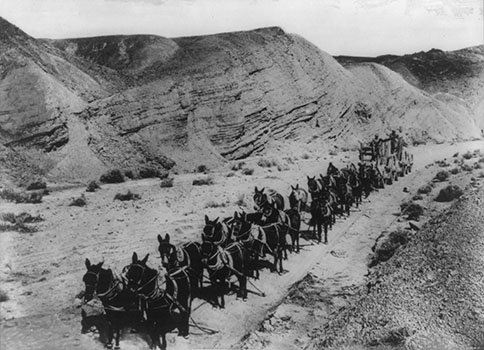 20 Mule
Team Borax Wagons in the Mojave Desert -
20 Mule
Team Borax Wagons in the Mojave Desert -
between 1880-1890 |
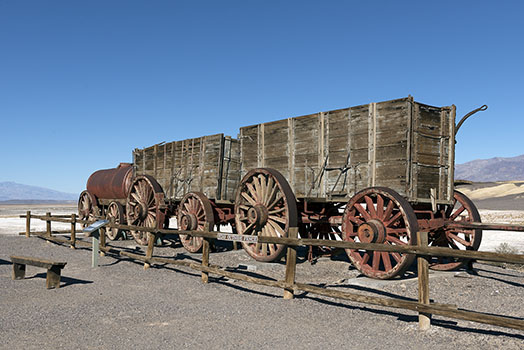 20 Mule
Team Borax Wagons in the Death Valley
20 Mule
Team Borax Wagons in the Death Valley |
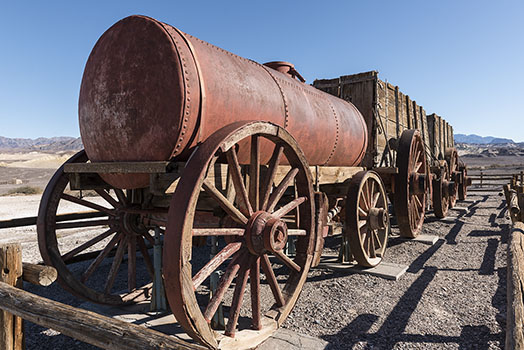 20 Mule
Team Borax Wagons in the Death Valley
20 Mule
Team Borax Wagons in the Death Valley |
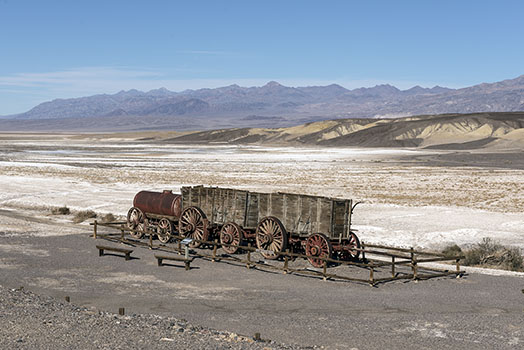 20 Mule
Team Borax Wagons in the Death Valley
20 Mule
Team Borax Wagons in the Death Valley |


Twenty-mule team hauls two freight wagons and a tank wagon in train through the forbidding terrain of Death Valley in California. The freight wagons are 16 feet long; their rear wheels are seven feet in diameter. Each wagons weighs nearly four tons and can carry 10 ten tons of cargo. The water tank holds 1,200 gallons of water. The 20-mule teams were used in the 1880's to carry borax from Death Valley to the railroad at Mojave, 165 miles away. The United States Borax & Chemical Corporation uses the team as its trademark.
(Pacific Coast Borax Company photo). |

|